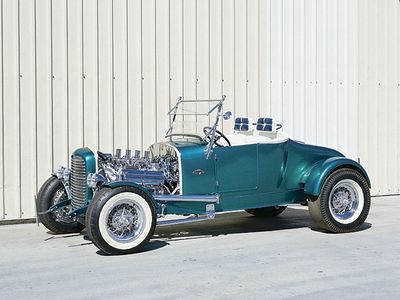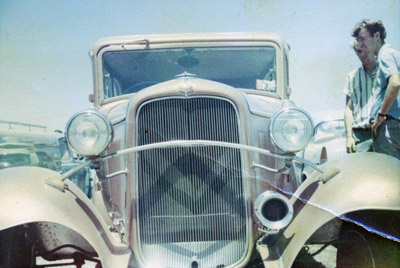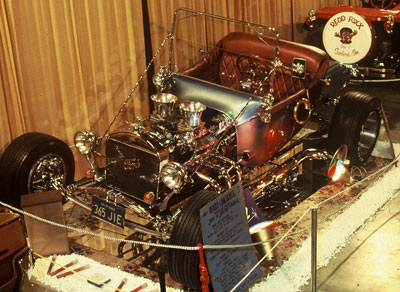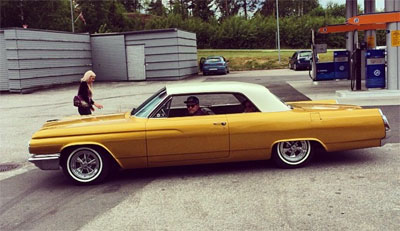Metalflake Paint










































Metalflake paint, also known as metallic paint or metal flake, is a type of automotive paint that contains small metallic particles, or flakes, suspended in the paint. These flakes reflect light, giving the paint a shimmering, sparkling effect. Metalflake paint is commonly used on custom cars, motorcycles, bicycles, and boats, as well as on various consumer products such as musical instruments and home appliances.
Contents
History
The use of metallic particles in paint can be traced back to ancient civilizations. Egyptians used powdered metals such as gold and silver to create brilliant, reflective surfaces on their artifacts.[3] The modern metalflake paint was developed in the late 1950s. In 1959 Barris Kustoms debuted their futuristic air car, the XPAK 400 at the New York World's Fair. The XPAK 400 featured 35 coats of nitro cellulose lacquer, that according to a press release by Barris Kustoms, contained a million particles of chromed aluminum called "Metalflake". The press release could further state, that Metalflake was a revolutionary new development by the Bobeckmun Company, a Division of the Dow Chemical Company. The particles were precision cut, coated aluminum foil that gave a metallic finish, and it was supposedly the first time the product was available for commercial use. A trial was offered to George Barris for the XPAK 400 since it was going to be displayed at the National Car Show in Detroit. George used plain silver flake for the body. The overall reflection quality of the flake was softened by the addition of a small amount of pearl. "George’s early experience with the flake proved that it would be a wild wild finish, subtle and velvet soft in the indirect lighting, yet extremely lively where the strong light is directed". The fins featured 30 coats of imported Swedish pearl of essence which was made of crushed fish scales and crushed diamond dust. It was also painted in Kandy translucent red, white and blue.[4]
Dick Scritchfield's 1932 Ford Roadster
Dick Scritchfield's 1932 Ford roadster is known as the first car to ever receive a Metalflake paint job. Dick painted the car at a friends body shop in Eagle Rock, California toward the end of 1960. He used two toners to arrive at the exact color he wanted. Rather than using gold Metalflake as base for the Candy Apple Red, Dick used silver Metalflake, with the final color coming closer to magenta or cherry red. After Dick had painted the car, his buddy Tex Smith thought it would be a good idea to drive it down to Dean Jeffries for a photo shoot. The Metalflaked version of Dick's roadster, that Tex shot, was featured in Hot Rod Magazine February 1961 in a cover story about Metalflake paint. As the photo shoot was done at Jeffries' shop, many thought it was Jeffries that applied the Metalflake on the car. The article did also discuss that an "older car was painted at Dean Jeffries", which made it sound like it was Dick's roadster. In 2013 Dick told Kustomrama that "Dean was a great guy, and he could have painted it, but he didn't. It was at a time where I was learning and doing most of the work myself, since money was tight in those days." The older car mentioned in the story was actually Tex Smith's Buick, not Dick's roadster. The Buick paint did not make it to "show" or even "street" quality, and Dick can't remember how Tex got rid of it. Dick always enjoyed Tex's saying that the roadster looked "quite distinctive on Hollywood Boulevard." According to himself, "it was really bad (and I don't mean good) by today's meaning. Barris' came out much better. The large flakes were a bit "gaudy" for my tastes, so I opted for the smaller, less intrusive which the Bobeckmun Company provided. They were the original manufacturers and gave me pointers on spraying the flake. All the details were in the magazine article. With the new gravity feed guns, it would be much easier to apply. It really takes lots of clear coats, especially if using the large flake."[1]
Types of Metallic Flakes
There are various types of metallic flakes used in metalflake paint, including aluminum, mica, and glass. Aluminum flakes are the most common, as they are lightweight and highly reflective.[5] Mica flakes offer a more subtle shimmer and are often used in pearlescent and color-shifting paints. Glass flakes, on the other hand, create a more prismatic effect and are used in paints that require a higher degree of durability.[6]
Application
Applying metalflake paint requires skill and patience, as the flakes need to be distributed evenly across the surface to achieve a consistent, uniform appearance. The process usually involves applying a base coat of solid color paint, followed by a coat of clear paint mixed with the metallic flakes. Finally, several layers of clear coat are applied to protect the finish and enhance the depth and shine of the paint.[7]
Challenges
One of the main challenges of working with metalflake paint is achieving a consistent distribution of the flakes. Uneven distribution can result in a patchy appearance, with some areas having a higher concentration of flakes than others. Additionally, metalflake paint is more susceptible to UV damage and oxidation than non-metallic paint, making it essential to apply a UV-resistant clear coat to protect the finish.[8]
Metalflaked Cars
Steve Scott's Uncertain-T
Joe and Jerry Valdez's 1921 Ford Model T Roadster
Bo Sandberg's 1923 Ford Model T Roadster - Purple Passion
John Toohey's Royal-T Ford Model T C Cab
Gary Heliker's 1926 Ford Model-T Roadster
George Barris' 1927 Ford Model T Roadster - The Twister T
Henrik Forss' Bucket T
Art Lehner's 1932 Ford 3-Window Coupe - The Blue Indigo
John Caldwell's 1932 Ford Four-Door Sedan
Lars Erik Ljungkvist's 1932 Ford Roadster
Deaner Probst's 1933 Ford Cabriolet - Lil' Dough
Bengt Wennergren's 1949 Ford
Ed Pogue's 1953 Ford Hardtop - The Glitra
Roy Abendroth's 1955 Buick Century - The BuSonic
Josie Celeste's 1957 Chevrolet Bel Air - Angel Lust
Jim and George Bernardo's 1957 Plymouth Convertible
Adam Woodhams' 1959 Buick LeSabre - The Lone Wolf
Dave and Sue Wright's 1959 Chevrolet Brookwood Station Wagon - The Headhunter
Bill Leslie's 1960 Ford Thunderbird - The Golden Gem
Dennis McPhail's 1960 Ford Fairlane
Howard Gribble's 1961 Ford Starliner
Jim Robertson's 1961 Ford
Tom Røine's 1963 Buick
Bob Nordskog's 1963 Chevrolet Corvette - The Asteroid
John Viggianelli's 1963 Ford Galaxie
Marco Hämäläinen's 1975 Saab 96 - WaSaabi
Bo Sandberg's Cool Cat
Colin Hillier-Daines' Agent Thor
The Reactor
The XPAK 400
References
- ↑ 1.0 1.1 Dick Scritchfield
- ↑ www.streetrodderweb.com
- ↑ Lucas, A. (1925). Ancient Egyptian Materials and Industries. London: Edward Arnold & Co
- ↑ Barris Kustoms
- ↑ Koleske, J. V. (2012). Paint and Coating Testing Manual. ASTM International.
- ↑ Schröder, K. (2016). Automotive Paints and Coatings. Wiley-VCH.
- ↑ Taylor, K. (2008). Automotive Custom Paint. Motorbooks International.
- ↑ Bock, R. (2016). Modern Automotive Paint Technology. SAE International.
Did you enjoy this article?
Kustomrama is an encyclopedia dedicated to preserve, share and protect traditional hot rod and custom car history from all over the world.
- Help us keep history alive. For as little as 2.99 USD a month you can become a monthly supporter. Click here to learn more.
- Subscribe to our free newsletter and receive regular updates and stories from Kustomrama.
- Do you know someone who would enjoy this article? Click here to forward it.
Can you help us make this article better?
Please get in touch with us at mail@kustomrama.com if you have additional information or photos to share about Metalflake Paint.
This article was made possible by:
SunTec Auto Glass - Auto Glass Services on Vintage and Classic Cars
Finding a replacement windshield, back or side glass can be a difficult task when restoring your vintage or custom classic car. It doesn't have to be though now with auto glass specialist companies like www.suntecautoglass.com. They can source OEM or OEM-equivalent glass for older makes/models; which will ensure a proper fit every time. Check them out for more details!
Do you want to see your company here? Click here for more info about how you can advertise your business on Kustomrama.







